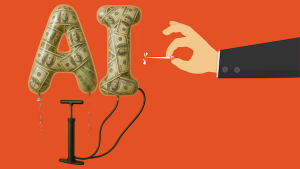This paper argues that (i) we have reached “peak GenAI” in terms of current Large Language Models (LLMs); scaling (building more data centers and using more chips) will not take us further to the goal of “Artificial General Intelligence” (AGI); returns are diminishing rapidly; (ii) the AI-LLM industry and the larger U.S. economy are experiencing a speculative bubble, which is about to burst.
The U.S. is undergoing an extraordinary, AI-fueled economic boom: The stock market is soaring thanks to exceptionally high valuations of AI-related tech firms, which are fueling economic growth by the hundreds of billions of U.S. dollars they are spending on data centers and other AI infrastructure. The AI investment boom is based on the belief that AI will make workers and firms significantly more productive, which will in turn boost corporate profits to unprecedented levels. But evidence is piling up that generative AI (GenAI) is failing to deliver. This paper argues that (i) we have reached “peak GenAI” in terms of current Large Language Models (LLMs); scaling (building more data centers and using more chips) will not take us further to the goal of “Artificial General Intelligence” (AGI); returns are diminishing rapidly; (ii) the AI-LLM industry and the larger U.S. economy are experiencing a speculative bubble, which is about to burst (because of the first point); and (iii) the U.S. bet the farm on a future dominated by U.S.-owned AGI, because, for geopolitical reasons, it could not afford to risk to lose the AI-race with China; this geopolitical bet on AGI is now going bad.



